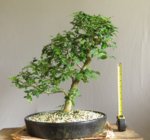Lazylightningny
Masterpiece
The ideal bonsai root mass is comprised of a thick mat of small feeder roots, flat on the bottom. Let's say you bare root a typical nursery plant. There will be a lot of thick anchor roots that terminate in feeder roots. How do you get from there to the beautiful, dense mat of feeder roots with no thick anchor roots needed for bonsai culture? Especially for conifers, it's a daunting concept.


 20180320_124031
20180320_124031 20180321_175048
20180321_175048 20170929_183246
20170929_183246 2017-10-15_03-19-34
2017-10-15_03-19-34


